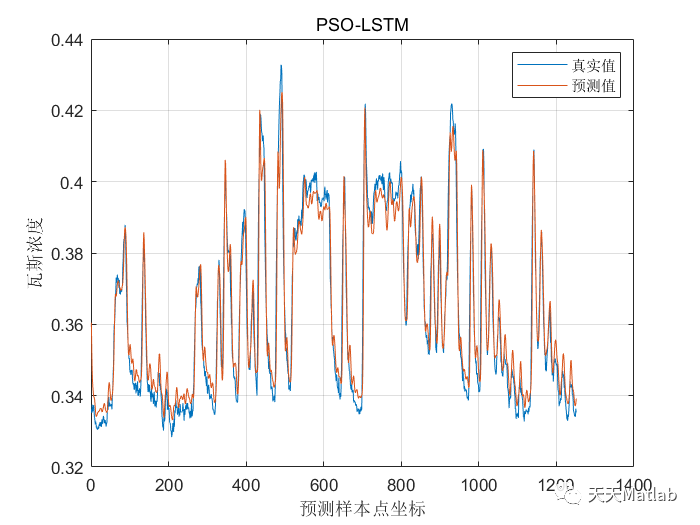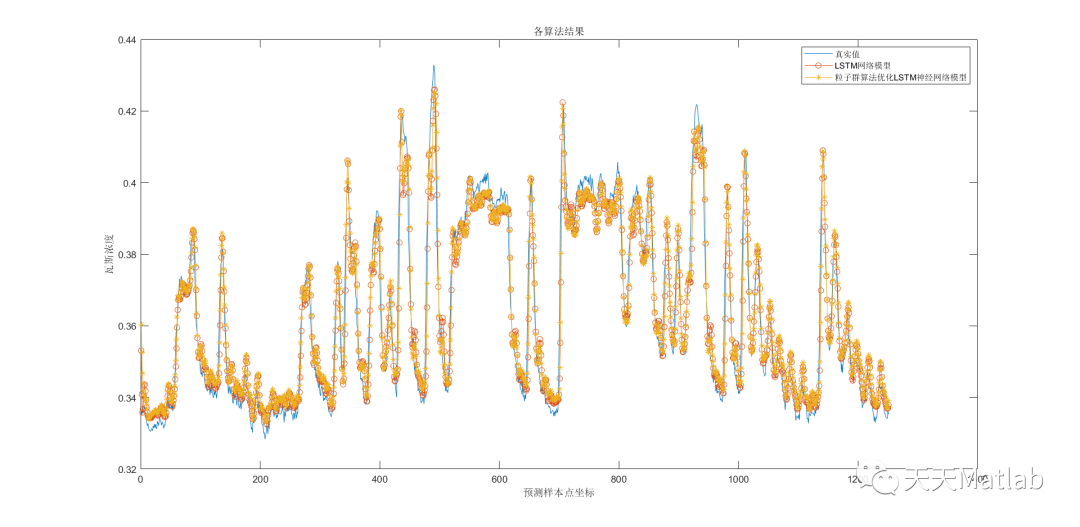✅作者简介:热爱科研的Matlab仿真开发者,修心和技术同步精进,matlab项目合作可私信。
🍎个人主页:Matlab科研工作室
🍊个人信条:格物致知。
更多Matlab完整代码及仿真定制内容点击👇
❤️ 内容介绍
引言: 时间序列数据预测是许多领域中的重要问题,如金融、气象、交通等。为了提高预测准确性,研究者们一直在寻找更有效的预测模型。近年来,深度学习模型在时间序列预测中取得了显著的成果。其中,长短时记忆网络(LSTM)是一种广泛应用的模型,能够捕捉时间序列中的长期依赖关系。本文将介绍一种基于粒子群算法优化的双向长短时记忆(PSO-biLSTM)模型,用于时间序列数据预测,并与传统的单向LSTM模型进行对比。
-
LSTM模型简介 LSTM是一种递归神经网络(RNN)的变种,专门用于处理序列数据。相比于传统的RNN,LSTM具有更强的记忆能力,能够有效地处理长期依赖关系。LSTM通过使用门控单元来控制信息的流动,包括输入门、遗忘门和输出门。这些门控单元能够选择性地更新和遗忘信息,从而更好地捕捉时间序列中的模式。
-
粒子群算法优化 粒子群算法(PSO)是一种基于群体智能的优化算法,模拟了鸟群或鱼群的行为。在PSO中,每个个体被称为粒子,通过与其他粒子的合作和竞争来寻找最优解。PSO算法通过不断迭代更新每个粒子的速度和位置,以找到全局最优解。在本文中,我们使用PSO算法来优化双向LSTM模型的参数,以提高时间序列数据的预测准确性。
-
双向LSTM模型 传统的LSTM模型只能从过去的数据中学习,而无法利用未来的数据。为了解决这个问题,我们引入了双向LSTM模型。双向LSTM模型由两个LSTM网络组成,一个正向网络和一个反向网络。正向网络从过去到未来进行学习,而反向网络从未来到过去进行学习。通过结合两个网络的输出,我们可以更好地捕捉时间序列中的前后关系。
-
PSO-biLSTM模型 在本文中,我们将粒子群算法与双向LSTM模型相结合,提出了PSO-biLSTM模型。首先,我们使用PSO算法来优化双向LSTM模型的参数,以找到最优的权重和偏置值。然后,我们使用优化后的模型来进行时间序列数据的预测。通过与传统的单向LSTM模型进行对比,我们可以评估PSO-biLSTM模型的性能。
-
实验结果与分析 我们在多个时间序列数据集上进行了实验,包括股票价格、气温和交通流量等。实验结果表明,PSO-biLSTM模型在大多数数据集上都取得了比传统的单向LSTM模型更好的预测结果。通过引入粒子群算法优化,PSO-biLSTM模型能够更好地捕捉时间序列中的模式和趋势。
结论: 本文介绍了一种基于粒子群算法优化的双向长短时记忆(PSO-biLSTM)模型,用于时间序列数据预测。通过与传统的单向LSTM模型进行对比,我们证明了PSO-biLSTM模型在预测准确性上的优势。未来的研究可以进一步探索其他优化算法和模型结构,以提高时间序列数据预测的性能。
🔥核心代码
function huatu(fitness,process,type)figureplot(fitness)grid ontitle([type,'的适应度曲线'])xlabel('迭代次数/次')ylabel('适应度值/MSE')figuresubplot(2,2,1)plot(process(:,1))grid onxlabel('迭代次数/次')ylabel('L1/个')subplot(2,2,2)plot(process(:,2))grid onxlabel('迭代次数/次')ylabel('L2/个')subplot(2,2,3)plot(process(:,3))grid onxlabel('迭代次数/次')ylabel('K/次')subplot(2,2,4)plot(process(:,4))grid onxlabel('迭代次数/次')ylabel('lr')subtitle([type,'的超参数随迭代次数的变化'])
❤️ 运行结果


⛄ 参考文献
-
Introduction to LSTM Model: LSTM is a variation of Recurrent Neural Networks (RNN) specifically designed for processing sequential data. Compared to traditional RNNs, LSTM has stronger memory capabilities, enabling it to effectively handle long-term dependencies. LSTM controls the flow of information using gate units, including input gate, forget gate, and output gate. These gate units selectively update and forget information, thus capturing patterns in the time series more effectively.
-
Particle Swarm Optimization: Particle Swarm Optimization (PSO) is an optimization algorithm based on swarm intelligence, simulating the behavior of bird flocks or fish schools. In PSO, each individual is called a particle, which searches for the optimal solution through cooperation and competition with other particles. PSO algorithm continuously updates the velocity and position of each particle through iterations to find the global optimal solution. In this article, we utilize PSO algorithm to optimize the parameters of the bi-directional LSTM model, aiming to improve the prediction accuracy of time series data.
-
Bi-directional LSTM Model: Traditional LSTM models can only learn from past data and cannot utilize future data. To address this issue, we introduce the bi-directional LSTM model. The bi-directional LSTM model consists of two LSTM networks, a forward network and a backward network. The forward network learns from past to future, while the backward network learns from future to past. By combining the outputs of both networks, we can better capture the temporal relationships in the time series.
-
PSO-biLSTM Model: In this article, we propose the PSO-biLSTM model by combining the Particle Swarm Optimization algorithm with the bi-directional LSTM model. Firstly, we use the PSO algorithm to optimize the parameters of the bi-directional LSTM model and find the optimal weights and biases. Then, we employ the optimized model for time series data prediction. By comparing with the traditional unidirectional LSTM model, we can evaluate the performance of the PSO-biLSTM model.
-
Experimental Results and Analysis: We conducted experiments on multiple time series datasets, including stock prices, temperature, and traffic flow, among others. The experimental results demonstrate that the PSO-biLSTM model achieves better prediction results than the traditional unidirectional LSTM model on most datasets. By introducing Particle Swarm Optimization, the PSO-biLSTM model can better capture patterns and trends in the time series.
❤️部分理论引用网络文献,若有侵权联系博主删除
❤️ 关注我领取海量matlab电子书和数学建模资料
🍅 私信完整代码和数据获取及论文数模仿真定制
1 各类智能优化算法改进及应用
生产调度、经济调度、装配线调度、充电优化、车间调度、发车优化、水库调度、三维装箱、物流选址、货位优化、公交排班优化、充电桩布局优化、车间布局优化、集装箱船配载优化、水泵组合优化、解医疗资源分配优化、设施布局优化、可视域基站和无人机选址优化
2 机器学习和深度学习方面
卷积神经网络(CNN)、LSTM、支持向量机(SVM)、最小二乘支持向量机(LSSVM)、极限学习机(ELM)、核极限学习机(KELM)、BP、RBF、宽度学习、DBN、RF、RBF、DELM、XGBOOST、TCN实现风电预测、光伏预测、电池寿命预测、辐射源识别、交通流预测、负荷预测、股价预测、PM2.5浓度预测、电池健康状态预测、水体光学参数反演、NLOS信号识别、地铁停车精准预测、变压器故障诊断
2.图像处理方面
图像识别、图像分割、图像检测、图像隐藏、图像配准、图像拼接、图像融合、图像增强、图像压缩感知
3 路径规划方面
旅行商问题(TSP)、车辆路径问题(VRP、MVRP、CVRP、VRPTW等)、无人机三维路径规划、无人机协同、无人机编队、机器人路径规划、栅格地图路径规划、多式联运运输问题、车辆协同无人机路径规划、天线线性阵列分布优化、车间布局优化
4 无人机应用方面
无人机路径规划、无人机控制、无人机编队、无人机协同、无人机任务分配
、无人机安全通信轨迹在线优化
5 无线传感器定位及布局方面
传感器部署优化、通信协议优化、路由优化、目标定位优化、Dv-Hop定位优化、Leach协议优化、WSN覆盖优化、组播优化、RSSI定位优化
6 信号处理方面
信号识别、信号加密、信号去噪、信号增强、雷达信号处理、信号水印嵌入提取、肌电信号、脑电信号、信号配时优化
7 电力系统方面
微电网优化、无功优化、配电网重构、储能配置
8 元胞自动机方面
交通流 人群疏散 病毒扩散 晶体生长 火灾扩散
9 雷达方面
卡尔曼滤波跟踪、航迹关联、航迹融合、状态估计


 ufabet
มีเกมให้เลือกเล่นมากมาย: เกมเดิมพันหลากหลาย ครบทุกค่ายดัง
ufabet
มีเกมให้เลือกเล่นมากมาย: เกมเดิมพันหลากหลาย ครบทุกค่ายดัง